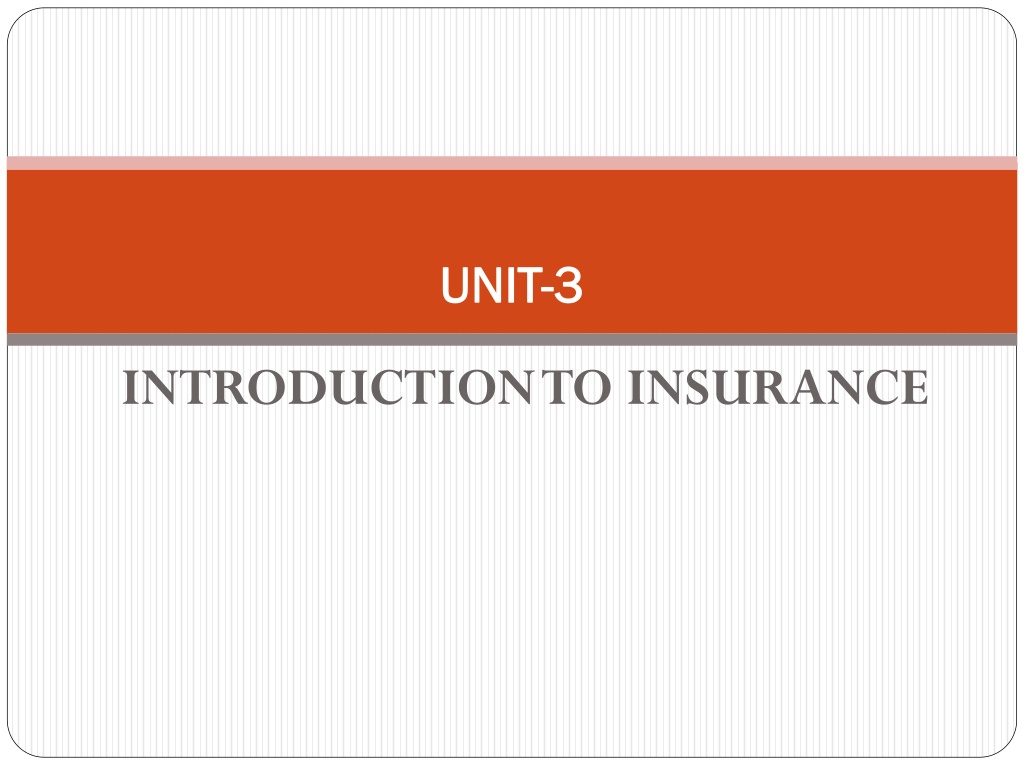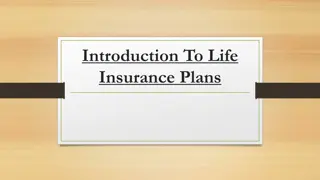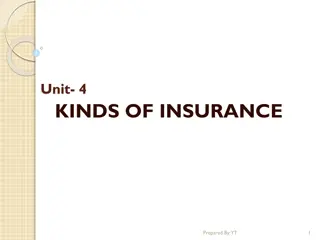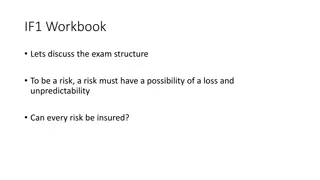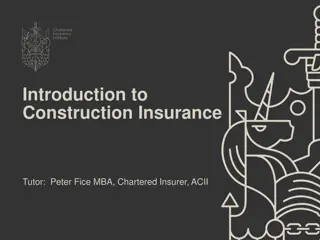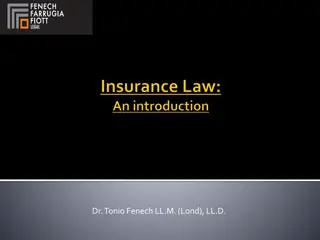Understanding Insurance: Managing Risks and Protecting Yourself
Risk is inevitable in life, and insurance plays a crucial role in mitigating its impact. Through pooling risks and providing certainty, insurance contracts offer protection against unforeseen events. This section explores the importance of insurance, its various definitions from economic, legal, and business perspectives, and how it serves as a vital risk management tool in our daily lives.
Download Presentation

Please find below an Image/Link to download the presentation.
The content on the website is provided AS IS for your information and personal use only. It may not be sold, licensed, or shared on other websites without obtaining consent from the author. Download presentation by click this link. If you encounter any issues during the download, it is possible that the publisher has removed the file from their server.
E N D
Presentation Transcript
UNIT UNIT- -3 3 INTRODUCTION TO INSURANCE
3.1 Introduction 3.1 Introduction Risk is a fact of life.We are confronted with so many risks in our daily life. It is not possible for individuals to avoid risk totally. It is also difficult to forecast all the risks and calamities that are going to happen in the future. Many happy families are ruined by unexpected death of a person on whom the family is dependent. Many persons lost part of their body due to accident, precious properties at times consumed or lost by the various perils such as fire,flood,burglaries,and accidents. These sufferings may be reduced by precautionary measures. For example efficient police department will reduce the incidence of burglaries, relief department may lessen the sufferings due to floods, very alert fire brigade can control a fire and reduce loss, efficient medical service may enhance the average expectations of life. However, these measures cannot eliminate burglaries,flood,fire or death.
3.1 Introduction 3.1 Introduction (Cont .) (Cont .) There fore, the various risks that we face in our day-to-day life cannot be totally avoided. But its effect can be lessened. However, the ultimate victims of these risks cannot bear these consequences by themselves; as a result it is a necessity for a device or institution to provide the needed help to these unfortunate individuals and organizations. Such a device is known as insurance and the institution, which provides such help, is called insurance company. In this section of the material we will discuss this important risk management device-insurance in detail.
3.2 What is Insurance? 3.2 What is Insurance? (Cont .) (Cont .) Some times it is difficult to define certain terms. However, it is possible to describe them. Some definition, though not comprehensive by themselves may provide reasonably sufficient explanations about the term insurance. The following are some of the definitions given by different scholars. Insurance may be defined in economic, legal business, social, and mathematical point of view as follows; 1. In Economic sense; insurance is an important tool that provide certainty or predictability aiming at reducing uncertainty in regard to pure risks.It accomplishes this result by pooling or sharing of risk. 2. Legal point of view ; insurance is a contract by which one party, in consideration of the price paid to him adequate to the risk, becomes security to the other that he shall not suffer loss,damage or prejudices by the happening of the perils specified in the policy.
3.2 What is Insurance? 3.2 What is Insurance? (Cont .) (Cont .) Article 6549(1) of the commercial code of Ethiopia state insurance as follows; A contract where by a person called the insurer undertakes against payment of one or more premiums to pay a person, called the beneficiary, sum of money where a specified risk materializes. From this definition we can learn that insurance is contractual agreement between two parties; the person (insured) and insurance companies. When a person buys private insurance, she/he is entering into a contract with the insurer that entitles the person (insured) to certain advantages but also imposes certain responsibilities such as payment of a premium and satisfying certain conditions specified in the policy. 3. Business point of views; as a business institution, insurance has been defined as a plan by which large number of people associate themselves and transfer risks of individuals to the shoulders of the members of the policy.
3.2 What is Insurance? 3.2 What is Insurance? (Cont .) (Cont .) 4. Social view point ; insurance is defined as a social device for making payment for the accumulation of fund to meet uncertain losses of capital which is carried out through the transfer of risk of many individuals to one person or a group of persons. It is advice through which few unfortunates are paid by many who are member of the policy. 5. Mathematical view point; insurance is the application of actuarial (insurance mathematics) principles. Laws of probability and statistical techniques are used to achieve predictable results. Williams and Hein s defines defined insurance as a device by means of which the risks of two or more persons or firms are combined through actual or promised contributions to a fund out of which claimants are paid. Dins dale and McMurdie also defined insurance as a device for transfer of risks of individual entities to an insurer, who aggress, for a consideration (called the premium),to assume to a specified extent losses suffered by the insured.
3.2 What is Insurance? 3.2 What is Insurance? (Cont .) From the definitions,it can be learned that 1. Insurance is a system used to transfer risk of individuals for payment of premium. The insured considers insurance as a transfer device where as from the point of view of the insurer (insurance company) ,it is regarded as retention and combination device. Of course, one may ask, why the insurer accept risks that other people try to avoid. Insurance companies /insurers accept the risks of others because, as compared to individual insured; I. They have the knowledge and the skill into apply various risk reduction and risk control measures; II. Combination or pooling of similar risks will enable the insurer to predict the actual loss experience with a reasonable accuracy. III. They have financial capacity to assume /take risk. IV. They are in a position to enforce certain loss reduction and prevention and prevention measures V. For losses that are beyond their capacity, insurers arrange a reinsurance mechanism (Cont .)
3.2 What is Insurance? 3.2 What is Insurance? (Cont .) From this we can say that risk in the business of insurance companies. The insured is required to pay some amount of money in relation for the transfer of his/her risk to the insurer .they do this because they want to remain secured financially and/or mentally. 2. It is a scheme that establishes a common fund out of which financial compensation is mode to these who faces accidental losses. 3.It is a pooling of risks of money people who are exposed to the same risk. 4. It is a device used to spread the loss suffered by an individual or firm to the members.In the group. 5. It is a method to provide security to the insured person against the probable loss. (Cont .)
3.3 Social and Economic Values of Insurance 3.3 Social and Economic Values of Insurance Insurance is obviously desirable that we can enumerate several advantage or value to the social well-being and economic development of a nation. Some of the advantages are discussed below. Risk transfer /Indemnification The primary objective of insurance is to provide financial compensation to these insured who suffered accidental losses. Indemnification is made out of the fund established by the member s contribution or premium payment, who are exposed to the same risk. This means, the loss is spread to all members on equitable basis and the financial burden of the unfortunate is reduced and he is restored to his former financial position. by doing so insurance helps stabilize the financial situation of individuals, families and organizations. 1.
3.3 Social and Economic Values of Insurance 3.3 Social and Economic Values of Insurance (Cont .) 2.Reduction of uncertainty Insurance reduces the physical and mental stress that insured face concerning the risk of loss and provides peace of mind. It is a psychological benefit that may not be quantified but still of great importance. Insurance reduces worries and anxieties and help every one work in a relaxed manner, which can make every one to work productive and perform his duties properly with out anxiety. This has direct implication on the society because the society will be secured from unexpected loss and interruption of services from those who will face unexpected loss. 3.Encourage savings Insurance is a contractual agreement between the insurer and the insured, where the insured is expected to pay a premium for the risk he/she transferred to the insurer.This compulsory premium payments are a form of encouragement of the insured to make systematic saving particularly, this is possible in certain life insurance polices that have dual purpose, i.e., protection in the event of death and savings in the event of survival. (Cont .)
3.3 Social and Economic Values of Insurance 3.3 Social and Economic Values of Insurance (Cont .) (Cont .) 4.Help businesses continue with out interruption of operation The insured firm will not be knocked out of business by fire or liability or other insurable risks. The insurer indemnifies the losses and restores the firm to its former position. This is also advantageous to the society because they can get uninterrupted services and goods of the firm .moreover, insurance helps small business since they cannot bear all the risks by themselves. By transferring their risk,can safely perform their operation and compete with larger firms. 5.Provide funds for investment Premiums collected by insurance companies are not left stagnant. They are used to provide a big source long-term investment capital for the national economy. The loan is made available to investors through banks and it serves as a stimulant for the national economy to be healthier.
3.3 Social and Economic Values of Insurance 3.3 Social and Economic Values of Insurance (Cont .) 6.Keeps families together Family can continue to live together after disastrous adversaries. For example, if a husband with life insurance dies, it may not force his family to disintegrate due to lack of income because they can receive the compensation from the insurer and can earn their live as it was before at least to some extent It relieves pressure on social warfare system, there by reserving government resources for essential social security activities. 7.Provides a Basis for credit Insurance policies are used as a guarantee for personal and business bank loans. This day s banks lend money on the basis of the collateral security of insurance. 8.Promotes loss control systems In order to minimize their losses, insurance companies have tried and are continuing to introduce severer kinds of loss reduction and prevention schemes. For example, health education, inspection, of elevators, and boilers, installation of fire extinguishers, burglar, and alarms, on vehicles or houses are risk control mechanisms developed and applied by insurance companies at different times.The introduction of this loss control programs can reduce losses to businesses and individuals and complement good risk management there by benefiting society as a whole. (Cont .)
3.3 Social and Economic Values of Insurance 3.3 Social and Economic Values of Insurance (Cont .) 9.It provides financial stability to the community Insurance makes a remarkable contribution to the society as a whole. It creates certainty in the environment there by stimulating competition among business enterprises in a certain region. Fair competition is a greater advantage to the society since it reduces price, encourage efficient utilization of scarce resources and produce quality products. Insurance also avoids or at least minimizes production stoppage that produces an economic wastage, and results in loss of profit to the insured, unemployment and loss of trade and services to the business community.So,insurance can minimize all these and other consequences of risk. 10.Stimulates international trade and commerce Goods traded at the international market are highly vulnerable to risk of loss due to large number of perils. As a result it is difficult to think of international trade with out insurance. Insurance coverage may be a condition for engaging in international trade and commerce. Insurance serves as a lubricant of trade;with out it trade and commerce may stifle. (Cont .)
3.4.1 Disadvantages/Costs of Insurance 3.4.1 Disadvantages/Costs of Insurance Insurance is not with out some problems. It has the following major problems; 1. It encourages Freud to collect dishonest claims (moral hazard problems). When individuals are insured against a particular risk, they may intentionally increase the chance of loss,or exaggerate the claim. 2. Increases carelessness in life (morale hazard problem); it is a condition that causes to be less careful than they would otherwise be. Some individuals do not consciously seek to bring about a loss, but the fact that they have insurance causes them to take more risks than they would if they had no insurance coverage. This manner may result in excessive losses in the community. 3. Cost of insurance; insurance incur operating expenses such as loss control costs , loss adjustment expenses, expense involved in acquiring insured,(advertisement cost),state administrative costs. In addition to these expenses, the insured is expected to cover a reasonable amount for profit and contingencies. premium taxes, and general
3.4.2 Limitations of Insurance 3.4.2 Limitations of Insurance Insurance is clearly a useful device for handling risk, but some risks cannot safely be handled by insurance. It is a device used to deal with pure risks only. Even not all pure risks are insurable. That means, insurance dose not provide protection against a wide range of risks. It has a limited application you may question;what types of risks are insurable? To give an answer to this question, it is necessary to discuss the characteristics of insurable risks in other words, for insurance to be used as a risk transfer mechanism the following conditions must be met to identify the insurable risks from those which can not be commercially insurable.
Characteristics of Insurable Risks Characteristics of Insurable Risks 1. A large number of independent units should be exposed to the same risk. This requirement follows from the low of large numbers a mathematical principle which states that a risk that is not predictable for one persona can be forecasted accurately for sufficiently large groups of people with similar characteristics. Insurance operation is safe only when the insurer is able to predict fairly and accurately its expected losses. If the pool of policy holders is small, volatility in number of claims can lead to unexpected increase in claim and hence bankrupt the plan the insurance company. Therefore,there must be a sufficiently large number of risks of a similar class being insured so as to predict accurately the average loss experience. 2.It must be possible to calculate/measure the chance of loss in monetary terms
Characteristics of Insurable Risks Characteristics of Insurable Risks 3. The loss should be definite, in time, place, cause and amount; otherwise claim adjustment will be difficult. 4. The loss should be accidental from the view point of the insured as distinguished from the expected loss. For example, losses on account of depreciation cannot be insured, as there is nothing accidental about their occurrence. 5. The possible loss must not be catastrophic. The risks covered by insurance should affect only a relatively small portion of the total insured population at a given time. If a risk is likely to cause similar damage to a large proportion of policy holders at the same time, a single occurrence of the risk would bankrupt the insurance companies. There fore, with certain exceptions, it is usual to find exclusions regarding fundamental risks such as war and earthquake in all insurance contracts. 6. There must be a insurable interest. An insurance contract provides security against the consequences of a loss and is basically concerned with preserving the interest of the insured, one who possesses insurable interest (financial relationship) in the subject matter of insurance can avail the insurance protection.
Characteristics of Insurable Risks Characteristics of Insurable Risks 7.The potential loss must be large.The risk should not be very minor one and the peril must be capable of causing a loss so large that the insured cannot bear it himself without economic distress. 8. The cost of insurance should not be prohibitive. The cost of insuring (premium) must be economically feasible and with in the reach of nearly every one; otherwise it will be confined to a very small section of the society. For instance, who would be willing to pay birr 1000 or2000 to insure the risk of losing a 100 birr property/ if you are rational person, the answer is definitely no the premium should be reasonable. 9. The risk must be consistent with public policy. The insurance contract should not be against the public policies,for examples,insurance affected by terrorists for fines imposed for the offences. 10. The insured must be subject to real risk what ever may be the subject matter of insurance for which the insured seeks protection, the subject matter must be adversely affected on the happening of the event i.e., the subject matter must be potentially exposed to the risk.
Insurable Risks Insurable Risks The following are generally insurable risk Pure risks; property (direct and indirect property losses; personal and legal liability losses. non-catastrophic losses risk with low probability of occurrence 1. 2. 3. Un Un- -insurable Risks insurable Risks The following are generally un-insurable risk 1. Speculative risks such as market risks, 2. Fundamental risks (war, earth-quark, political and economic losses). 3. Wear and tear of goods, e.g. Depreciation 4. Risk that are against public policy.
3.5 Basic Principles of Insurance 3.5 Basic Principles of Insurance The legal or fundamental principles are common to all types of insurance contracts. With the exception of indemnity, which is not applicable to personal insurance contracts? These principles are discussed briefly as follows; A. Insurable interest For an insurance contract to be valid, the insured must possess an insurable interest in the subject matter of insurance. Insurable interest refers to the existence of financial relationship to the subject matter insured. The subject matter of insurance may be a property, life or legal liability. The insurable interest to be valid must be recognized as such under the low and must satisfy the following conditions. 1. There must be some subject matter of insurance such as physical object or potential liabilities; 2. there must be risk to which the subject matter is exposed 3. The insured must have some legally recognized relationship with the subject matter insured. 4. The insured should stand to benefit by the safety of the subject matter and should incur loss by its destruction or damage ;and 5. The subject matter should be measurable in terms of money.
3.5 Basic Principles of Insurance 3.5 Basic Principles of Insurance Generally, in the case of life insurance, insurable interest must exist at the inception of the policy. In the case of property insurance, with few exceptions, insurable interest must exist both at the time of effecting insurance and the time of loss. The doctrine of insurable interest in property is to prevent insurance from becoming gambling contract and in life insurance it is required in order to prevent acts of murder. Insurable interest may take the following ways, i.e., ownership, lawful possession, contract or insurer. B. Utmost good faith or Uberrimae fedei Insurance contracts are based up on mutual trust and confidence between the insurer and the insured. This principle requires each party to tell the other the truth, the whole truth and nothing but the truth. It means that both the insured and insurer must make full disclosure of material facts and information relating to the contract or facts that have a bearing on the assessment of the risk. Material facts are of the following types; 1. Those which affect the nature or incidence of risk; and 2. Those which affect the character of insured. Non-disclosure, concealment, innocent misrepresentation, and fraud may lead to avoidance or cancellation of the insurance contract by one of the parties to the contract.
3.5 Basic Principles of Insurance 3.5 Basic Principles of Insurance C. Indemnity The principle of indemnity states that the insured, in the event or loss, receives financial compensation equal to the amount of the face value of the policy, which ever is lower. The whole purpose is to restore the insured to his/her former financial position. Thus, the principle eliminates the intention of gambling, which incorporates profit motive. It is the controlling principle in insurance contract that limits compensation. This principle is not applicable to personal insurances because the loss due to risk cannot be calculated and so a previous agreement regarding the amount payable on the happening of risk is made between the insurer and the insured. Indemnity implies that; There must be an actual loss The loss should have occurred through the risk insured The loss must be capable of calculation in terms of money The payment made by another person (third party) should not exceed the actual loss suffered. Indemnity can take different forms; cash payment, replacement of property or reinstatement of the property or repair.
3.5 Basic Principles of Insurance 3.5 Basic Principles of Insurance D. Subrogation Subrogation is the right to an insurer who has paid a claim under a policy issued by him to receive the benefit of all rights and remedied of the insured will extinguish or diminish the ultimate loss sustained. It is the right of one person (the insurer) to stand in the place of another (the insured) to avail himself on the latter s rights and remedies. Principle of subrogation is a supplement to the principle of indemnity. The reason behind this principle is to eliminate the profit motive of the insured. That means, the insured cannot claim both from the insurer and the wrong doer for single accident, which would enable him/her collect more than what was actually lost. Subrogation implies that; The insurer makes payment to the insured for his actual loss The insurer after making good the loss, places himself in the position of the insured and has all the rights and remedies of the insured The insurer cannot recover anything more than he has paid to the insured Like principle of indemnity, principle of subrogation is not applicable to life insurances.
3.5 Basic Principles of Insurance 3.5 Basic Principles of Insurance E. Contribution Contribution is also corollary of/or supplement of the principle of indemnity. The doctrine of this principle preaches for an equitable distribution of any loss among insurers. In other words it applies that when there is more than one policy covering the same subject matter against the same peril for the same period and for the same insured. In this case, the insured can make claims under all policies with different insurers and recover pro rata from each. Contribution is the right of an insurer who has paid a loss under a policy to recover a proportionate amount from other insurers who are liable for the same loss; The principle of contribution is enforceable only under the following conditions; The policies must cover the same period The policies must have been enforce at the time of loss They must protect the same peril The subject matter of insurance must be the same, and The insured must be the same person. Note the principle of contribution is not applicable to life insurances.
3.5 Basic Principles of Insurance 3.5 Basic Principles of Insurance F. Proximate cause The maxim causal proximal non remote specter means that proximate (nearest) cause and not the remote one is to be taken notice of at the time of determining the liability of the insurer. The insurer is not liable for remote cause even if it is one of the insured risks for the occurrence of the risk of which the insured is to be compensated. The insurer is liable to make the payment of loss under the policy, otherwise not. The insured may recover the loss from the insurer only when; The loss has been caused by the insured peril ; and The cause has been proximate to the loss. There fore, the insurer is not liable for the loss due to a proximate cause, which is not an insured peril.
3.5 Basic Principles of Insurance 3.5 Basic Principles of Insurance Example Ato Abe be insured his car worth of br.500,000 in two insurance companies; Ethiopian insurance corporation and Awash insurance company for br.300,000 and br.200,000 respectively. While the policy is in force the car was damaged due to collusion done intentionally by Kebede. The loss is estimated to be br. 200,000. Required A. How much each insurance company is going to pay to Ato Abebe? why? B. How much Ato Abebe is going to claim? Why? C. Abebe has an intention to claim compensation from the two insurance companies and Kebede at the same time. Advice what he/she should do?
3.5 Basic Principles of Insurance 3.5 Basic Principles of Insurance Answers A. the insured has the right to claim compensation from the insurer as far as the policy is in force an amount equal to the loss or face value of the policy.(indemnity principle). Due to contribution principle, abebe can claim the amount of loss (br.200, 000) from the two companies. They contribute to the loss based on the proportion insured. The proportion is calculated as; For EIC =300,000 = 0.6 = 60% 500,000 For awash insurance Company = 200,000 = 0.4=40% 500,000 B. Ato abebe can collect a total of br. 200,000 an amount of the loss; and 120,000br(60%x200,000) from EIC and 80,000br(40% 200,000) from awash. C. ATO abebe cannot collect from the insurance companies and the wrong doer Ato kebede because of the principle of indemnity and subrogation.
3.6 Insurance Contract 3.6 Insurance Contract Understanding of the legal interpretation of insurance contract can be important to a risk manager, for several reasons. One reason in fundamental in deciding whether to use insurance or some other risk management tools, the insured or the risk manager should know what the insurer promises to do under the contract. The risk manager should understand the rights and responsibilities of the insurer and the insured under the contract. Insurance contracts are subject to the same basic low that governs all types of contracts. But insurance contracts have many characteristics not found in most other contracts. A set of special features discussed below applies to insurance contracts. Insurance contracts are agreements between the insurance companies and the insured for the purpose of transferring from the insured to the insurer part of the risk or loss arising out of contingent events.
3.6 Insurance Contract 3.6 Insurance Contract The contract serves the following functions; 1. Define the risk to be transferred 2. State the conditions under which the contract parties should know such as premium and performance of certain acts. 3. Explain the procedures for selling loss claims.
3.6.1 Distinguishing Features of Insurance 3.6.1 Distinguishing Features of Insurance Contracts Contracts Features discussed below tend to distinguish insurance from other contracts. 1. Personal Contract Insurance contract s is personal contracts. Although the subject of a property insurance. Contract is an item of property, the contract insures the legal interest of a person or an entity not the property it self. If the owner of a car (Mr. Y) sells the car to Mr. x, the new owner Mr. is not insured under the contract unless the insurer aggress to an assignment of the insured s (Mr. s) rights to new owner (Mr. x) 2. Unilateral Contract Insurance contracts are commonly unilateral contracts. After the insured has paid the premium and the contract has fulfilled his/her promise to pay the premium .the term unilateral means that courts will enforce the contract in one direction only; against one of the parties; in this case, the insurer. A typical contract other than insurance is bilateral. However, in some case the insured may promise to pay premium during the contract period. In this situation, the contract becomes bilateral.
3.6.1 Distinguishing Features of Insurance Contracts 3.6.1 Distinguishing Features of Insurance Contracts (Cont ) (Cont ) 3. Conditional Contract Insurance contracts are conditional contracts. Although only the insurer can be forced to perform after the contract is effective, the insurer can refuse to perform if the insured does not satisfy certain conditions contained in the contract. For instance, the insurer need not pay a claim if the insured has increased the chance of loss in some manner prohibited under the contract or has failed to submit a proof of loss with in a specified period. 4. Aleatory Contract Insurance contract are Aleatory contracts, i.e., the obligation of at least one of the parties to perform is dependent up on chance. If the event insured against occurs, the insurer will probably pay the insured a sum of money much larger than the premium. If the event does not occur, the insurer will pay nothing. 5. Contract of Adhesion Insurance counteract is usually contracts of adhesion. The insured seldom participates in the drafting of the contract. Usually the insurer offers the insured a printed document on a take- it-or-leave-it-basis. Courts frequently refer to this characteristic of insurance contracts when they interpret ambiguous provisions in favor of the insured. And interpreted for the benefit of the insured.
3.6.1 Distinguishing Features of Insurance Contracts 3.6.1 Distinguishing Features of Insurance Contracts (Cont ) (Cont ) 6. Contracts of Uberrimae Fidei The literal meaning of uberrimae fidei is utmost good faith that can be restated as the highest standard honesty. Insurance contracts are contracts of the utmost good faith. Both parties to the contract are bound to disclose all the facts relevant to the transaction. Neither party is to take advantage of the other s lake of information. 7. Contract of Indemnity Property and liability insurance contracts are contracts of indemnity. The person insured should not benefit financially from the happening of the even insured against. because insurance do not allow insured s to make profit from happening of a particular risk. Life and frequently health insurance contracts of indemnity.
3.6.2 Requirements for a Valid Contracts 3.6.2 Requirements for a Valid Contracts According to the low of contract must satisfy some conditions before it is legally enforceable. Some of these are; 1. The contract must serve a legal purpose. 2. One party must make a definite offer and a second party must accept the offer. 3. Each party to the contract must be required to make some consideration on behalf of the other party. The contract is not enforceable unless one party gives up a right, power, or privilege that he/she already has in exchange for an equivalent renouncement by the other. 4. The parties to the contract must be legally competent. Insane, minors or intoxicated persons are not considered competent. For instance, minors may void a contract to which they are a party; expect a contract of necessities (food, clothing and shelter etc. 5. The purpose of the contract should not be contrary to public interest.
3.6.3 Valid Elements Common to Insurance Contracts 3.6.3 Valid Elements Common to Insurance Contracts A valid insurance contract includes the following documents and conditions. they Application Binders Policy forms Endorsement 1. Application: is an offer to enter into a contract. The prospective insured sets forth the facts and figures required by the insurance company. Application may take oral or written from. 2. Binders: are temporary documents, which remains in force for few days for not more than 10 days.
3.6.3 Valid Elements Common to Insurance Contracts 3.6.3 Valid Elements Common to Insurance Contracts 3. Policy forms: policy form is a formal written contract of insurance. the common provisions included in this document are Declarations ; this identifies the insured, describe the property, activity or life being insured, states the types of coverage purchased ,terms of coverage, and indicates the premium paid. The purpose of declaration is to give sufficient information needed for the insured. Insuring agreements; this part states what the insurer promises to do. Exclusions; the contract may exclude certain perils, property, sources of liability, persons, losses, locations or time periods. Conditions; this prescribe certain conditions that should be met by the insured. 4. Endorsement: is a form that is used to modify the policy contract.
